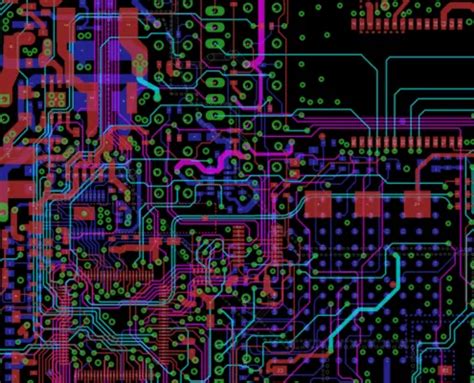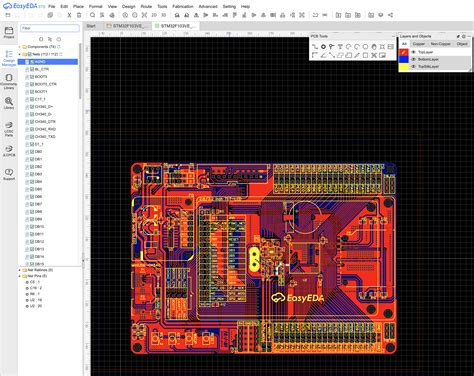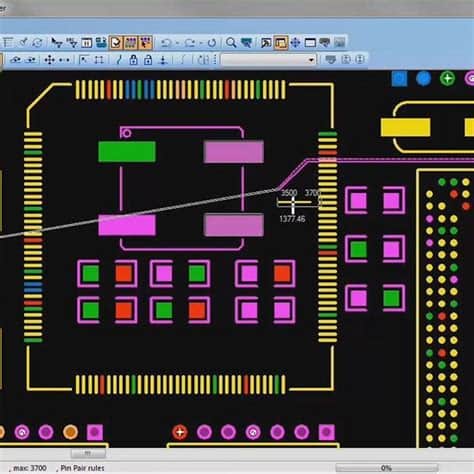What is PCB Design Software?
Before diving into specific tools, let’s define what PCB design software does. PCB design software provides an integrated environment to design the schematic diagram and physical layout of a printed circuit board. It includes features like:
- Schematic capture to create the logical circuit diagram
- PCB layout tools to design the physical board
- Component libraries with footprints and 3D models
- Design rule checking (DRC) to verify the PCB layout
- Autorouting to automatically route traces between components
- Outputs to generate manufacturing files like Gerber and drill files
Using PCB design software significantly speeds up the design process compared to manual methods. It allows engineers to quickly iterate on designs, catch errors early, and ensure the PCB can be efficiently manufactured.
Types of PCB Design Software
PCB design software comes in a few different varieties:
Desktop PCB Design Software
Traditional PCB design software runs on Windows, Mac or Linux as a desktop application. It offers the most control over every aspect of the design process. Examples include Altium Designer, OrCAD, EAGLE, and KiCad.
Web-Based PCB Design Software
Newer web-based PCB design tools run in a web browser, making it easy to design from anywhere. While not as full-featured as desktop software, they offer more simplicity and collaboration features. Examples include EasyEDA, Upverter, and CircuitMaker.
Open Source vs Paid
PCB design software also varies in cost and license:
- Open source software like KiCad is free to use.
- Paid software requires purchasing a license, costing hundreds to thousands of dollars. Most professional tools are paid.

Choosing PCB Design Software
With many PCB design tools available, how do you pick the right one? Consider these key factors:
- Ease of use – How quickly can you learn and start designing productively? Is the interface intuitive?
- Features – Does it have all the capabilities you need, like autorouting, 3D viewing, simulation, etc?
- Library – How extensive is the component library? Can you create/import custom parts?
- Community – Is there an active community offering resources, tutorials, and support?
- Outputs – Can it generate all the manufacturing files your PCB fab requires?
- Cost – Does the pricing model and budget make sense for your needs?
Let’s look at how the top PCB design software stack up across these criteria.

Best PCB Design Software
Here are our picks for the best PCB design tools for different types of users and needs:
1. Altium Designer – Best Overall
Altium Designer is widely considered the gold standard for professional PCB design. Used by top hardware companies, it provides an intuitive workflow for schematic and board design. Key features:
- Unified schematic and PCB layout environment
- Powerful routing tools and autorouting
- Real-time 3D view and MCAD collaboration
- Simulation and signal integrity analysis
- Flexible licensing for different team sizes
While one of the more expensive tools, Altium delivers best-in-class capabilities for complex PCB designs. Companies standardizing on one tool find Altium worth the investment.
2. KiCad – Best Free and Open Source
KiCad is the leading open source PCB design application. Offering schematic capture, PCB layout, and more, it provides a powerful free alternative to paid PCB software. Notable features include:
- Cross-platform Windows, Mac and Linux support
- Integrated component libraries and a 3D viewer
- Scripting and plugins for design automation
- No license costs for any user
While not as polished as paid tools, KiCad has a passionate community driving steady improvements. It is an excellent choice for hobbyists, students, and even many professional workflows.
3. Autodesk EAGLE – Best for Mechanical Integration
Autodesk EAGLE is a widely-used PCB design tool popular with both hobbyists and professionals. Now part of the Autodesk Fusion 360 platform, its strengths include:
- Clean, modern interface
- Integration with mechanical design in Fusion 360
- Large component library and ULP scripting
- Low-cost subscription and free educational licenses
While it lacks some advanced capabilities of Altium, EAGLE shines in workflows blending electronics and mechanical design. The tight integration with Fusion 360 simplifies designing PCBs alongside enclosures and assemblies.
4. OrCAD PCB Designer – Best Enterprise-Level
PCB-Designer/overview”>OrCAD PCB Designer is a high-end PCB design solution made by Cadence. Trusted for complex designs in aerospace, automotive, and more, it provides:
- Advanced schematic, layout, and routing features
- Simulation and signal/power integrity analysis
- Team design collaboration tools
- Extensive part creation and management
OrCAD targets enterprise customers with demanding requirements and established design processes. Its power and flexibility comes with a steeper learning curve and higher costs.
5. EasyEDA – Best Web-Based and Collaborative
EasyEDA is a newer web-based PCB design tool growing quickly in popularity. Requiring only a web browser to design hardware, it enables teams to work together more seamlessly than desktop tools. Features include:
- Real-time collaborative editing of schematics and PCBs
- Integrated component library and LCSC part sourcing
- Web-based simulators and waveform viewer
- Free accounts with low-cost paid upgrades
While not as fully-featured as desktop PCB tools, EasyEDA showcases the potential of web-based hardware design. For simpler boards, it provides a streamlined experience and tighter integration with part suppliers.

PCB Design Software Comparison
To summarize, here is a comparison table of the top PCB design software across key criteria:
| Software | Ease of Use | Features | Library | Community | Outputs | Cost |
|---|---|---|---|---|---|---|
| Altium | Medium | Advanced | Large | Strong | Industry | High |
| KiCad | Medium | Capable | Medium | Strong | Standard | Free |
| EAGLE | Easy | Capable | Large | Strong | Industry | Low |
| OrCAD | Hard | Advanced | Large | Medium | Industry | Enterprise |
| EasyEDA | Easy | Basic | Medium | Growing | Typical | Freemium |
Ease of Use: How quickly can a new user become proficient?
Features: How comprehensive are the tool’s capabilities?
Library: How extensive and high-quality are the component libraries?
Community: How large and active is the user community and ecosystem?
Outputs: How well does it support industry standard manufacturing outputs?
Cost: What is the pricing model and relative cost?
FAQ on Picking PCB Design Software
What is the easiest PCB design software to learn?
For beginners, web-based tools like EasyEDA tend to be the easiest to start using productively, since they simplify the setup and interface. EAGLE is also beginner-friendly among desktop PCB tools.
Is there a free PCB design software?
Yes, the open source KiCad provides a full-featured, cross-platform PCB design environment completely free. Web-based EasyEDA also offers free accounts for designing public projects.
How much does professional PCB design software cost?
Paid PCB design software typically costs hundreds to thousands of dollars, depending on the product and license. Altium Designer starts around $3000/year, while OrCAD can be over $10,000 for a perpetual license.
What PCB design software do most companies use?
Altium Designer is one of the most widely used PCB design tools among larger companies and professional engineers. OrCAD is popular for enterprise customers, while EAGLE leads among startups and smaller teams.
What else is needed besides PCB design software?
To go from design to a physical PCB, you’ll also need:
- Components, ordered from distributors or manufacturers
- PCB fabrication services to manufacture the bare board
- PCB assembly services to solder components on the board (unless hand assembling)
Choosing the right PCB design software is the first step of the hardware development process. While it requires evaluating your particular needs and budget, investing in a productive tool pays dividends in the long run.
By understanding the different types of PCB design software and comparing the leading options, you can find the best fit for bringing your electronic designs to life. Once you’ve selected your PCB design tool, you’ll be ready to start designing circuits efficiently and turn your ideas into real hardware products.
Conclusion
Ultimately, the best PCB design software for you depends on your specific requirements and constraints. Altium Designer provides the most power and polish for professional users. KiCad and EasyEDA offer compelling free and low-cost options. And EAGLE and OrCAD bring strong capabilities for integrated design and enterprise customers.
By weighing each tool’s ease of use, features, library, community, outputs and cost with your needs, you can find the optimal PCB design software to design hardware productively. With the right tool and workflow, you’ll be able to rapidly prototype ideas, verify and optimize your designs, and get to market quickly.

No responses yet